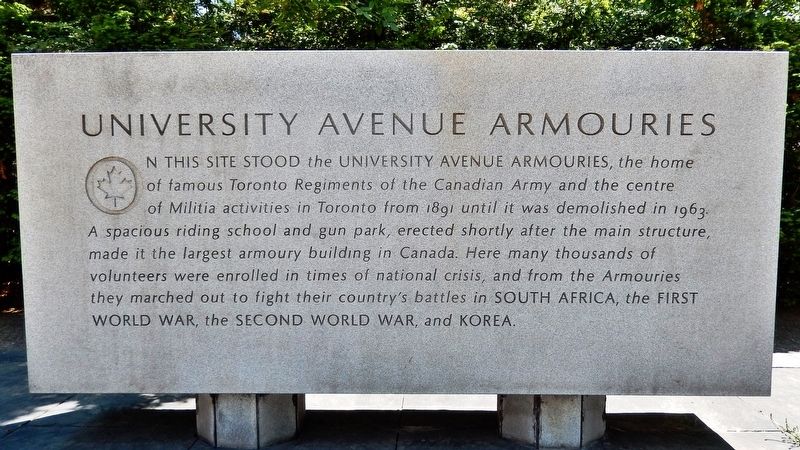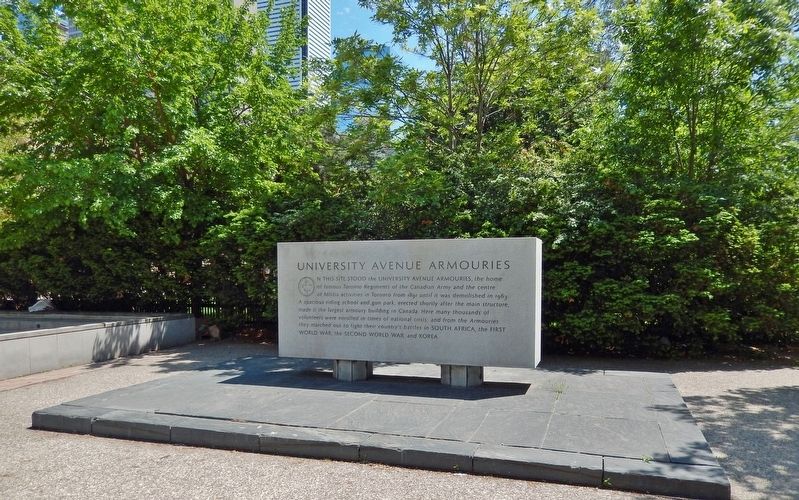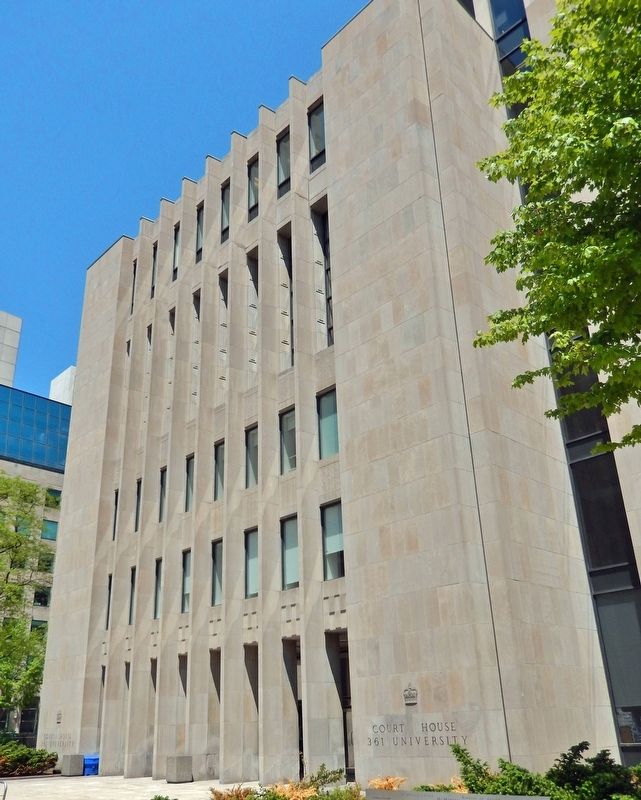Yonge-Bay Corridor in Toronto, Ontario — Central Canada (North America)
University Avenue Armouries
ON THIS SITE STOOD the UNIVERSITY AVENUE ARMOURIES, the home of famous Toronto Regiments of the Canadian Army and the centre of Militia activities in Toronto from 1891 until it was demolished in 1963. A spacious riding school and gun park, erected shortly after the main structure, made it the largest armoury building in Canada. Here many thousands of volunteers were enrolled in times of national crisis, and from the Armouries they marched out to fight their country's battles in SOUTH AFRICA, the FIRST WORLD WAR, the SECOND WORLD WAR, and KOREA.
Topics. This historical marker is listed in these topic lists: Architecture • Patriots & Patriotism • War, World I • War, World II. A significant historical year for this entry is 1891.
Location. 43° 39.142′ N, 79° 23.205′ W. Marker is in Toronto, Ontario. It is in Yonge-Bay Corridor. Marker is on University Avenue, 0.2 kilometers north of Queen Street West, on the right when traveling north. Marker is located in the plaza on the north side of Osgoode Hall. Touch for map. Marker is at or near this postal address: 361 University Avenue, Toronto ON M5G 1T3, Canada. Touch for directions.
Other nearby markers. At least 8 other markers are within walking distance of this marker. McMurtry Fountains / Fontaines McMurtry (within shouting distance of this marker); The Honourable R. Roy McMurtry (within shouting distance of this marker); Thanks and Remembrance (about 90 meters away, measured in a direct line); Walter Seymour Allward, R.C.A. (about 90 meters away); South African War Memorial (about 120 meters away); George Cox (about 120 meters away); University Club of Toronto Building (about 150 meters away); Women's Law Association of Ontario (about 150 meters away). Touch for a list and map of all markers in Toronto.
Also see . . .
1. Toronto Armories.
The Toronto Armories, also known as the University Avenue Armories and the Toronto Drill Hall, was an 1894 armoury building in downtown Toronto, Ontario, Canada. It was located on University Avenue, just north of Osgoode Hall. It was the largest armoury in the country and trained over 250,000 soldiers to serve Canada in various wars. It was sold in 1961 to the Metropolitan Toronto government for a new courthouse building and demolished in 1963.(Submitted on March 1, 2023, by Cosmos Mariner of Cape Canaveral, Florida.)The armoury building was designed by architect Thomas Fuller, then the Minister of Public Works. The foundation was made of Kingston limestone and the walls were 6 feet-thick. It was designed in the Romanesque Revival style with towers and castellations.
Inside, there was a drill hall measuring 280 by 125 feet, with a 72 feet-high ceiling.
2. Toronto’s lost armouries on University Avenue.
(Link presents photo of the armouries from the Toronto Archives. The view is of its west facade, on University Avenue.)
Built in 1891, the Toronto Armouries officially opened on May 17, 1894. Its inauguration was celebrated by a military tournament featuring different regiments — the Queen’s Own Rifles, 48th Highlanders, Royal Regiment, Royal Dragoons Toronto, and the Governor General’s Body Guard. The building had massively thick walls that were faced with red bricks and bonded with red mortar to create a continuously smooth appearance. Built on a solid foundation of Kingston limestone, the same type of stone was used as trim around the smaller windows and the huge arched windows on the west facade. The trim on the top of the towers, which were mediaeval in appearance, were also detailed with limestone.(Submitted on March 1, 2023, by Cosmos Mariner of Cape Canaveral, Florida.)
3. Provincial Law Courts and University Avenue Armouries.
The existing Provincial Court House marks the site of the earlier University Avenue Armouries. The armouries building was considered the finest of its class and, when it opened, was the largest in North America. Of red brick with stonework throughout, it was in the Romanesque style with towers, turrets, and castellations, it resembled a stout British castle. It was one of the most impressive buildings downtown Toronto. Here soldiers were trained for service in the Boer War and World Wars I and II. Apart from offices and classrooms, messes, and storage or kit rooms, there were bowling alleys and rifle ranges in the basement.(Submitted on March 1, 2023, by Cosmos Mariner of Cape Canaveral, Florida.)
Credits. This page was last revised on March 1, 2023. It was originally submitted on February 28, 2023, by Cosmos Mariner of Cape Canaveral, Florida. This page has been viewed 77 times since then and 12 times this year. Photos: 1, 2, 3. submitted on March 1, 2023, by Cosmos Mariner of Cape Canaveral, Florida.


